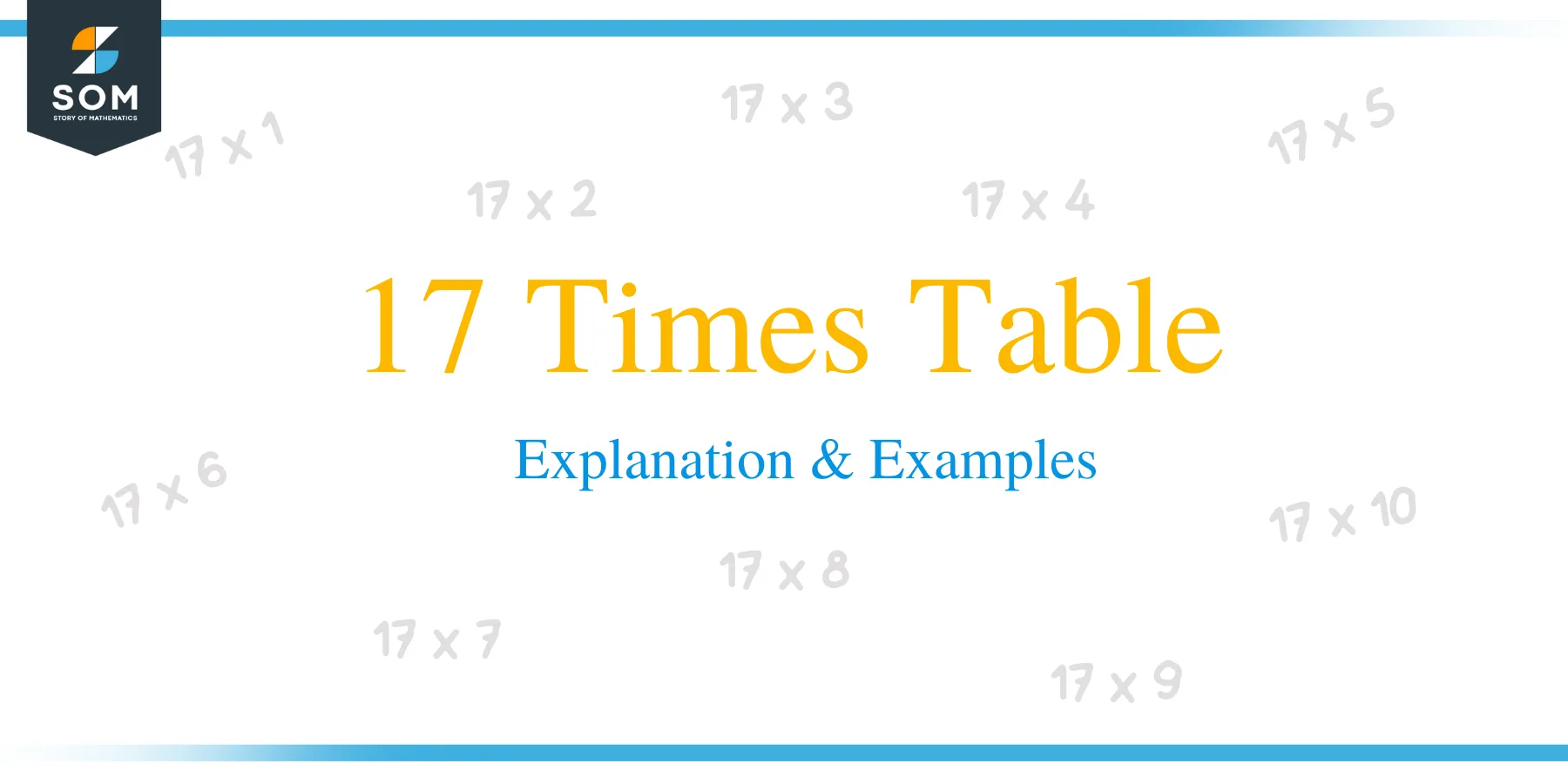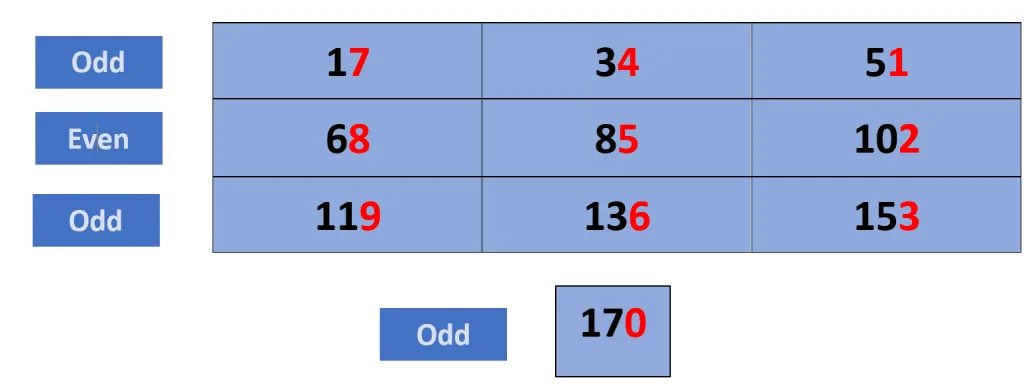- Home
- >
- 17 Times Table – Explanation & Example
JUMP TO TOPIC [show]
17 Times Table – Explanation & Examples
 The 17 times table is the multiplication table of the number 17. The number 17 is a prime number, and multiplication tables for prime numbers can be either easy or hard depending upon if they follow any pattern or not. The 17 times table is one of the easy ones as it follows a certain pattern.
The 17 times table is the multiplication table of the number 17. The number 17 is a prime number, and multiplication tables for prime numbers can be either easy or hard depending upon if they follow any pattern or not. The 17 times table is one of the easy ones as it follows a certain pattern.
17 times table is a table that contains the multiples of the number 17.
Learning and memorizing the 17 times table is essential for solving the multiplication, division, H.C.F, L.C.M, and factorization-related mathematical problems. We will present some tips and patterns that will help you learn and memorize the 17 times table in this topic.
You should refresh the following concepts to understand the material discussed here.
- Basics of addition and multiplication
- 7 times table
- 10 times table
17 Multiplication Table
The table of 17 can be written as:
Different Tips for the 17 Times Table:
Let us look at some simple tips which can help you memorize the 17 times table.
Using the 10 and the 7 Times Tables: If you have learned and memorized the 10 and the 7 times tables, this is one of the easiest methods to learn the 17 times tables, and it will also help you revise these tables. The method is quite simple as all you have to do is to add the multiples of the 10 times table to the same multiples of the 7 times table, and the outcome will be the multiples of the 17 times table. For example, the tenth multiple of 10 is 100, and the tenth multiple of 7 is 70, and if we add 100 and 70, we get 170 which is the tenth multiple of 17. The detailed method is presented in the table below.
10 Times Table | 7 Times Table | Addition | Outcome |
| | ||
Digits Pattern: This method is the easiest method to learn and memorize the 17 times table. Draw a 3 x 3 grid and then write the digits from 1 to 3 in the third column, digits 4 to 6 in the middle column, and 7 to 9 in the first column. Zero is written in a separate cell, as shown in the picture below.

Once the above table is formed, fill the first row with the first three odd numbers 1, 3, and 5. Fill the second row with even numbers 6, 8, and 10, and fill the third row and the last box with odd numbers 11, 13, 15, and 17, as shown in the picture below. The table now contains the first 10 multiples of the number 17.

Digits Pattern of the 7 Times Table: The ten’s digits of the first 10 multiples of the 7 times table are the same as those of the 17 times table. So, by using this method, you will find it easier to memorize the 17 times table, and it will also help you revise the 7 times table.

Table of 17 from 1 to 20:
A complete table of 17 from 1 to 20 can be written as:
Numerical Representation | Descriptive Representation | Product (Answer) |
Seventeen times one | ||
Seventeen times two | ||
Seventeen times three | ||
Seventeen times four | ||
Seventeen times five | ||
Seventeen times six | ||
Seventeen times seven | ||
Seventeen times eight | ||
Seventeen times nine | ||
Seventeen times ten | ||
Seventeen times eleven | ||
Seventeen times twelve | ||
Seventeen times thirteen | ||
Seventeen times fourteen | ||
Seventeen times fifteen | ||
Seventeen times sixteen | ||
Seventeen times seventeen | ||
Seventeen times eighteen | ||
Seventeen times nineteen | ||
Seventeen times twenty |
Example 1: Calculate 17 times 1 times 17 minus 300 plus 200.
Solution:
17 times 1 times 17 minus 300 plus 200 can be written as:
Example 2: Calculate 17 times 11 minus 2 times 17 plus 17.
Solution:
17 times 11 minus 2 times 17 plus 17 can be written as:
Example 3: Henry runs for 17 kilometers daily. Using the 17 times table calculate the total distance covered by Henry.
- If he runs 17 kilometers daily for 7 days
- If he runs 17 kilometers daily for 15 days
- If he runs 17 kilometers daily for 19 days
Solution:
- Henry runs 17 kilometers daily. By using the 17 times table, we can calculate the distance covered by him in 7 days as
- By using the 17 times table, we can calculate the distance covered by him in 15 days as
- By using the 17 times table, we can calculate the distance covered in 19 days as
Example 4: Sam has recently memorized the 17 times table. His mother wants to test his memorization skills and asked him to write the first five odd and even multiples of the number 17. What numbers would he write?
Solution:
Sam knows the first 10 multiples of 17 are 17, 34, 51, 68, 85, 102, 119, 136, 153, and 170.
So, the first five odd multiples are: 17, 51, 85, 119, and 153
The first five even multiples are 34, 68, 102, 136, and 170
Practice Questions:
- Andy has a total of 200 dollars in his wallet. If he buys 17 cupcakes, how much money will Andy be left with if one cupcake costs 3 dollars?
- Suppose the cost of one pencil is 2 dollars. Using 17 times table calculate the cost of 17 pencils?
- Find the value of “Y” if “
- From the given table, select the numbers which are multiples of 17
| 124 | 138 | 18 | 23 | 59 | 269 | 184 | 37 |
| 141 | 169 | 174 | 196 | 79 | 115 | 111 | 289 |
| 48 | 76 | 198 | 52 | 54 | 104 | 211 | 180 |
| 120 | 131 | 19 | 135 | 119 | 133 | 47 | 187 |
| 158 | 170 | 216 | 52 | 114 | 112 | 95 | 185 |
| 199 | 314 | 213 | 79 | 260 | 89 | 134 | 34 |
| 311 | 173 | 17 | 179 | 65 | 215 | 195 | 124 |
| 128 | 156 | 154 | 169 | 161 | 208 | 138 | 29 |
| 51 | 340 | 77 | 155 | 97 | 96 | 272 | 14 |
| 130 | 261 | 155 | 159 | 153 | 230 | 190 | 274 |
Answer Key:
1) Cost of one cupcake
If Andy buys 17 cupcakes, then the total cost of all the cupcakes will be
We also have to calculate the remaining amount Andy has after buying the 17 cupcakes. That amount can easily be calculated by subtracting the cost of 17 cupcakes from the total amount.
2) The cost of one pencil is = 2 dollars
Cost of 17 pencils will be
3)
We know that
4)
| 124 | 138 | 18 | 23 | 59 | 269 | 184 | 37 |
| 141 | 169 | 174 | 196 | 79 | 115 | 111 | 289 |
| 48 | 76 | 198 | 52 | 54 | 104 | 211 | 180 |
| 120 | 131 | 19 | 135 | 119 | 133 | 47 | 187 |
| 158 | 170 | 216 | 52 | 114 | 112 | 95 | 185 |
| 199 | 314 | 213 | 79 | 260 | 89 | 134 | 34 |
| 311 | 173 | 17 | 179 | 65 | 215 | 195 | 124 |
| 128 | 156 | 154 | 169 | 161 | 208 | 138 | 29 |
| 51 | 340 | 77 | 155 | 97 | 96 | 272 | 14 |
| 130 | 261 | 155 | 159 | 153 | 230 | 190 | 274 |
